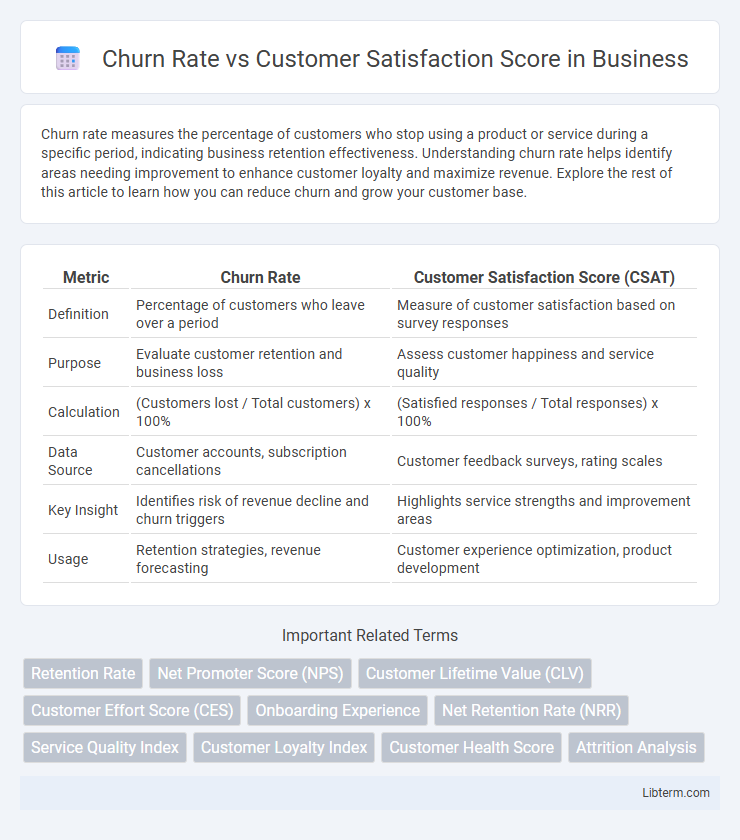Churn rate measures the percentage of customers who stop using a product or service during a specific period, indicating business retention effectiveness. Understanding churn rate helps identify areas needing improvement to enhance customer loyalty and maximize revenue. Explore the rest of this article to learn how you can reduce churn and grow your customer base.
Table of Comparison
| Metric | Churn Rate | Customer Satisfaction Score (CSAT) |
|---|---|---|
| Definition | Percentage of customers who leave over a period | Measure of customer satisfaction based on survey responses |
| Purpose | Evaluate customer retention and business loss | Assess customer happiness and service quality |
| Calculation | (Customers lost / Total customers) x 100% | (Satisfied responses / Total responses) x 100% |
| Data Source | Customer accounts, subscription cancellations | Customer feedback surveys, rating scales |
| Key Insight | Identifies risk of revenue decline and churn triggers | Highlights service strengths and improvement areas |
| Usage | Retention strategies, revenue forecasting | Customer experience optimization, product development |
Understanding Churn Rate: Definition and Importance
Churn rate measures the percentage of customers who stop using a product or service within a specific period, serving as a critical indicator of business health and customer retention. A high churn rate often signals dissatisfaction, poor customer experience, or competitive pressure, directly impacting revenue and growth potential. Understanding churn rate enables companies to identify underlying issues, optimize customer satisfaction strategies, and improve loyalty through targeted retention efforts.
What Is Customer Satisfaction Score (CSAT)?
Customer Satisfaction Score (CSAT) measures how satisfied customers are with a product or service, typically gathered through surveys asking users to rate their experience on a scale from 1 to 5. CSAT provides immediate feedback on customer happiness, allowing businesses to identify areas for improvement and enhance overall service quality. High CSAT scores generally correlate with lower churn rates, as satisfied customers are more likely to remain loyal and continue using the company's offerings.
Key Differences Between Churn Rate and CSAT
Churn Rate measures the percentage of customers who stop using a product or service during a given period, reflecting customer retention and business growth challenges. Customer Satisfaction Score (CSAT) quantifies how satisfied customers are with their experience, typically gathered through surveys immediately after interactions. The key difference lies in Churn Rate indicating long-term customer loyalty and loss, while CSAT captures immediate customer sentiment and satisfaction levels.
How Churn Rate Reflects Customer Retention
Churn rate directly measures the percentage of customers who stop using a product or service over a specific period, serving as a critical indicator of customer retention effectiveness. A high churn rate signals potential issues in customer satisfaction, product quality, or competitive alternatives, while a low churn rate often correlates with strong customer loyalty and positive experience. Monitoring churn rate alongside Customer Satisfaction Score (CSAT) helps businesses identify retention challenges and prioritize improvements that enhance long-term customer engagement and revenue stability.
Measuring Customer Satisfaction: Common Methods
Measuring customer satisfaction involves common methods such as surveys using the Customer Satisfaction Score (CSAT), Net Promoter Score (NPS), and Customer Effort Score (CES). These tools provide quantitative metrics that help correlate customer sentiments with churn rates, enabling businesses to identify pain points and improve retention strategies. Analyzing CSAT data alongside churn rate trends offers actionable insights for enhancing product and service quality.
The Correlation Between Churn Rate and CSAT
Churn rate and Customer Satisfaction Score (CSAT) share a strong inverse relationship where higher CSAT typically correlates with lower churn rates, indicating satisfied customers are more likely to remain loyal. Data from various industries show businesses with CSAT above 80% often experience churn rates below 10%, highlighting the impact of customer satisfaction on retention. Monitoring this correlation helps companies identify pain points, improve service quality, and reduce customer attrition effectively.
Factors Influencing High Churn Rate and Low CSAT
High churn rates often stem from poor customer experiences, unmet expectations, and ineffective communication, which directly degrade Customer Satisfaction Scores (CSAT). Factors such as delayed support responses, product quality issues, and lack of personalized service contribute to customer dissatisfaction and increase the likelihood of churn. Monitoring these key drivers enables businesses to implement targeted improvements that enhance satisfaction and reduce attrition.
Strategies to Reduce Churn and Improve Satisfaction
Effective strategies to reduce churn rate and improve customer satisfaction score include personalized customer engagement, proactive support, and continuous feedback loops. Leveraging data analytics to identify at-risk customers allows companies to tailor retention efforts and enhance product or service quality. Implementing loyalty programs and timely resolution of issues fosters trust and increases overall customer lifetime value.
Analyzing Data: Interpreting Churn and CSAT Together
Analyzing churn rate alongside Customer Satisfaction Score (CSAT) provides a comprehensive view of customer behavior by correlating service satisfaction with retention likelihood. High churn rates combined with low CSAT scores often indicate systemic issues in product quality or customer support that need urgent attention. Interpreting these metrics together enables businesses to identify at-risk customer segments and tailor strategic interventions to improve overall loyalty and profitability.
Actionable Insights: Optimizing Customer Experience
Analyzing churn rate alongside customer satisfaction score reveals critical pain points and areas for improvement in the customer journey. Lowering churn rate is directly linked to enhancing customer satisfaction through targeted interventions such as personalized support, streamlined onboarding, and responsive feedback loops. Leveraging these metrics together enables businesses to implement actionable strategies that boost retention and foster long-term loyalty.
Churn Rate Infographic

 libterm.com
libterm.com